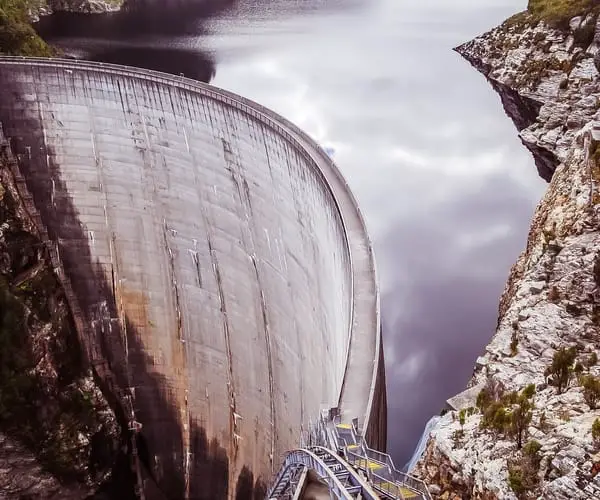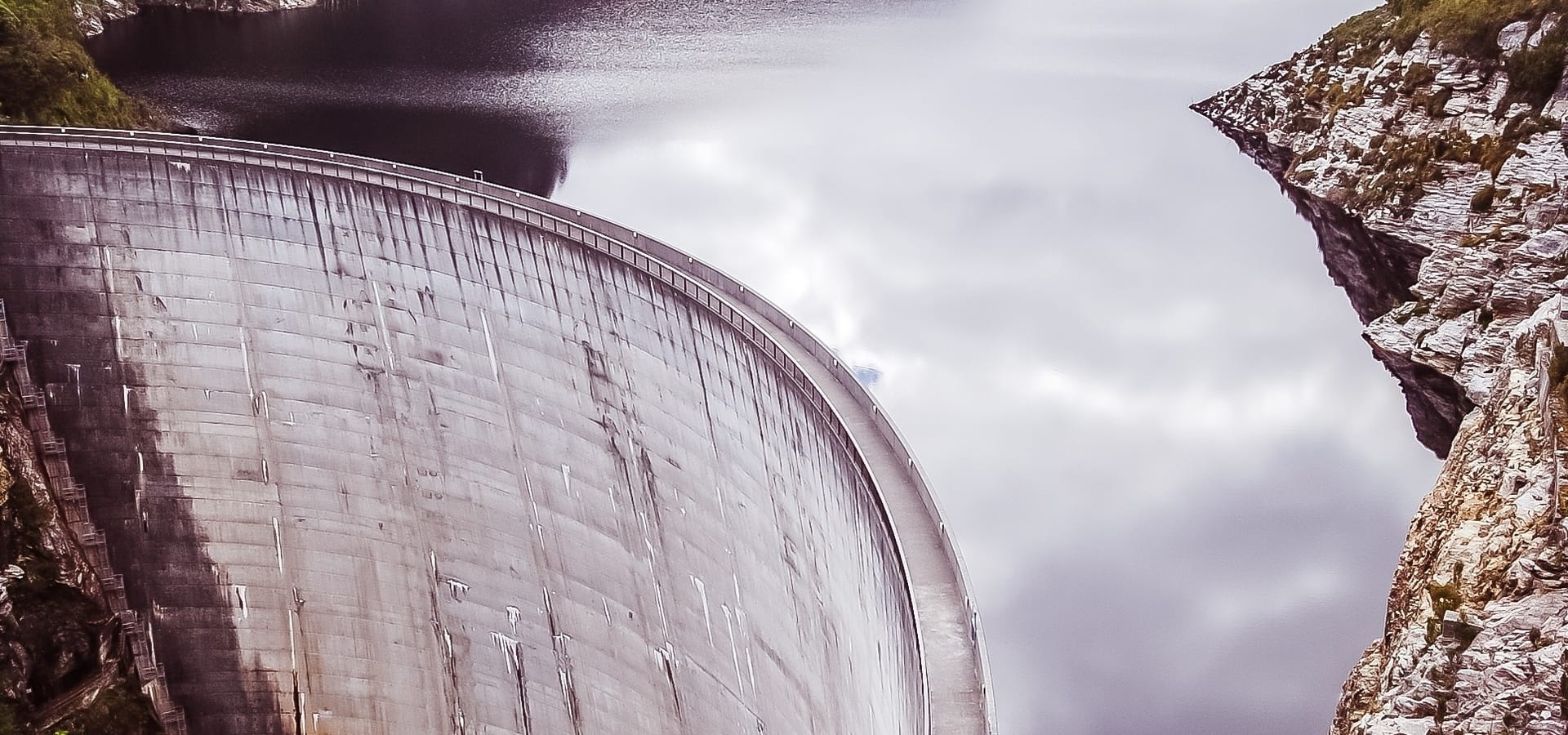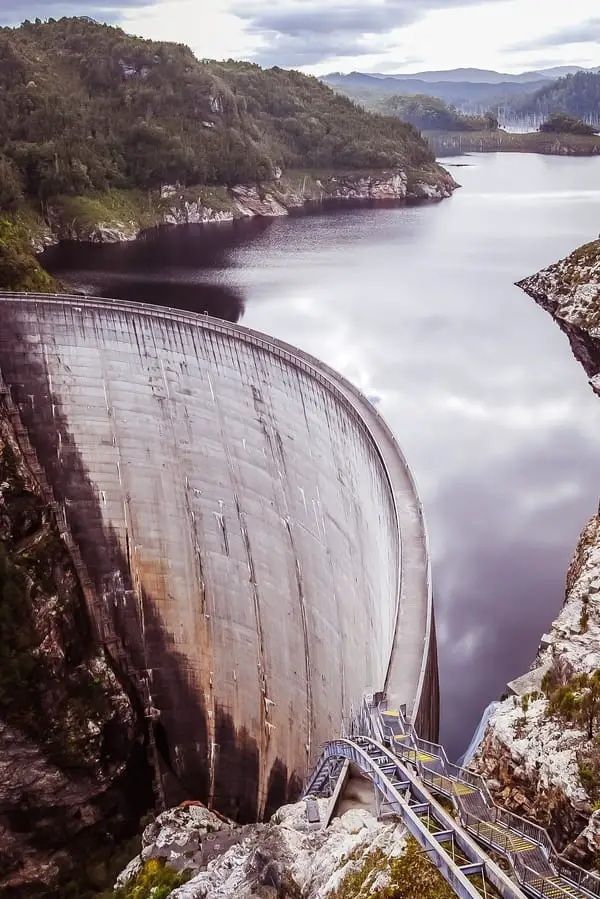Many people are unaware of the hidden treasures in South West Tasmania, but those who do simply love Gordon Dam and its surrounding habitat. Any travelling to the South West should see the Gordon Dam Wall, and brave travellers can choose between descending the stairs on to the face of the Gordon Dam or abseiling straight down the face of the wall.
The trek down the steel mesh steps or the abseil isn’t for the faint of heart, but it is absolutely worth it to enjoy the awe inspiring feat of engineering and the vista alike, with the dam wall already towering at a mammoth 140 metres and holding 30 times the water of Sydney Harbour. Gordon Dam is one of many dams used for Tasmania’s hydroelectricity. Despite man’s influence on the area, it’s still a beautiful place for nature lovers and the broader public to visit. There are over 300 rare types of ferns, lichens, and wildflowers can be found in this nature-rich region, as well as ancient Huon pines, some of the world’s tallest Swamp Gums, Sassafras, Myrtle, Celery Top Pine, and the Centurion or Mountain Ash, the world’s tallest flowering plant.
Key Visitor Information
Getting to Gordon Dam
The Gordon Dam is located at Strathgordon in the Franklin-Gordon Wild Rivers National Park, making it difficult to approach. The distance between you and Hobart is around 160 kilometres, and it will take you about 2.5 hours to get there. The journey from Launceston takes more than 4 hours, while the journey from Devonport takes 5 hours.
To get to the dam, you’ll have to follow the Gordon River Road, which is an out-and-back route with no picturesque loop. But don’t be concerned. The Gordon River Road passes through the Franklin-Gordon Rivers National Park and the Tasmanian World Heritage Area. There are numerous places along the route where you can stop for a breathtaking view or a brief nature walk.
Weather at Gordon Dam
There’s no doubt about it, Strathgordon, like the rest of South-West Tasmania, is cold. But don’t let it put you off! The cold and isolation adds to the beauty and intrigue of this beautiful part of Tasmania. Just remember to bring as many jackets, rain jackets (even in summer), scarves, beanies and gloves as you can.
- Average summer temperature is 19 degrees celsius
- Average autumn temperature is 14 degrees celsius
- Average winter temperature is 9 degrees celsius
- Average spring temperature is 14 degrees celsius
Best Known for
Gordon Dam has some beautiful bush surroundings which visitors love to see, but when you mention ‘Gordon Dam’ the first thing people think about is the colossal dam wall. It looks like something out of Bond movie – it creates intrigue and anyone who makes the trip to the south west will be almost guaranteed to visit, even if it is just for a quick look and a photo.
History of Gordon Dam
The Australian Government gave Tasmania’s Hydro-Electric Commission a $5 million grant in 1963 to create the Gordon River Road from Maydena to the Gordon River area in the South West Wilderness region. Construction began in 1964, and the Gordon River Power Development was approved by the Tasmanian State Parliament with little resistance three years later, in 1967. The first generator was installed in 1978, and a third was added in 1988.
Despite Tasmanian officials’ backing for the Franklin Dam further downstream, the Gordon Dam was the only dam erected on the Gordon River. The projected flooding of the connecting Lake Pedder occurred as a result of the construction of Gordon Dam. Following a Parliamentary enquiry in 1995, efforts to restore Lake Pedder were unsuccessful.
Dr. Sergio Guidici served as the principal engineer during the dam’s construction. He went on to work on the design of the Crotty Dam in the West Coast Range, one of Hydro Tasmania’s last major dams built during its rampant dam-building heydey.
The Gordon River Power Station is connected to the dam at a depth of 183 metres (600 feet) beneath the level of the switchyard.
Gordon Dam Wall

The Gordon Dam wall is 198 metres (650 feet) long and 140 metres (460 feet) high, making it the highest dam in Tasmania and the seventh tallest in Australia. It was built with 154 thousand cubic metres (5.4106 cubic feet) of concrete. The dam wall holds back 12,359,040 thousand cubic metres (436,455106 cu ft) of water at full capacity, making Lake Gordon Australia’s largest lake. The lake is 27,800 hectares (69,000 acres) in size, with a catchment area of 2,014 square kilometres (778 sq mi). The single controlled spillway can discharge 175 cubic metres per second (6,200 cubic feet per second).
In Australia, there are about 48 arch dams, however only nine of them feature double curvature. Gordon Dam is nearly twice as tall as Tumut Pondage, the second highest arch dam.
Water from the dam flows 183 metres (600 feet) underground to the power station, where three 144 megawatt (193,000 horsepower) turbines generate up to 432 megawatts (579,000 horsepower), meeting around 13% of Tasmania’s electrical consumption. The first two turbines were put into service in 1978, with the third following a decade later in 1988.
Water from Lake Gordon is used to power the plant. The McPartlans Pass Canal also draws water from Lake Pedder into Lake Gordon.
Abseiling Gordon Dam
Abseiling the 140 metre high Gordon Dam has been named one of the world’s top ten adrenaline activities.
At the top of the Dam, Aardvark Adventures has three abseil locations. Abseilers can practise their skills and warm up on the 30 metre and 50 metre descents. To add another level of fear and/or excitement, the Dam is concave, abseilers will not contact the wall for the most of their 140 metre drop.
Gordon Dam Walk
Any travelling to the South West should see the Gordon Dam Wall, and any brave traveller should descend the stairs on to the face of the Gordon Dam. The trek down the steel mesh steps is not for the faint of heart, but it is absolutely worth it to enjoy the awe inspiring feat of engineering and the vista alike, with the dam wall already towering at a mammoth 140 metres and holding 30 times the water of Sydney Harbour.


